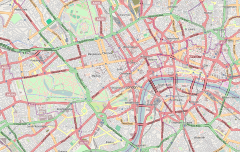Royal Albert Hall
| Royal Albert Hall | |
|---|---|

Royal Albert Hall from Kensington Gardens
|
|

Interior viewed from the Grand Tier
|
|
|
Location within Central London
|
|
| General information | |
| Type | Concert hall |
| Architectural style | Italianate |
| Address | Kensington Gore London, SW7 |
| Country | United Kingdom |
| Coordinates | 51°30′03.40″N 00°10′38.77″W / 51.5009444°N 0.1774361°W |
| Construction started | 18671 |
| Completed | 18711 |
| Inaugurated | 29 March 1871 |
| Renovated | 1996–2004 |
| Cost | £200,0001 |
| Client | Provisional Committee for the Central Hall of Arts and Sciences |
| Owner | The Corporation of the Hall of Arts and Sciences |
| Height | 135 feet (41 m) |
| Design and construction | |
| Architect | Captain Francis Fowke and Major-General Henry Y. D. Scott |
| Architecture firm | Royal Engineers |
| Main contractor | Lucas Brothers |
| Website | |
| royalalberthall.com | |
| References | |
|
1 – Victorian London: Royal Albert Hall 2 – Royal Albert Hall, London |
|
The Royal Albert Hall is a concert hall on the northern edge of South Kensington, London, which holds the Proms concerts annually each summer since 1941. It has a capacity of up to 5,272 seats. The Hall is a registered charity held in trust for the nation and receives no public or government funding.
Since its opening by Queen Victoria in 1871, the world's leading artists from many performance genres have appeared on its stage and it has become one of the UK's most treasured and distinctive buildings. The location of some of the most notable events in British culture, each year it hosts more than 390 shows in the main auditorium, including classical, rock and pop concerts, ballet, opera, film screenings with live orchestra, sports, award ceremonies, school and community events, charity performances and banquets. A further 400 events are held each year in the non-auditorium spaces.
The Hall was originally supposed to have been called the Central Hall of Arts and Sciences, but the name was changed to the Royal Albert Hall of Arts and Sciences by Queen Victoria upon laying the Hall's foundation stone in 1867, in memory of her husband consort, Prince Albert who had died six years earlier. It forms the practical part of a memorial to the Prince Consort – the decorative part is the Albert Memorial directly to the north in Kensington Gardens, now separated from the Hall by Kensington Gore.
In 1851, the Great Exhibition (for which the Crystal Palace was built) was held in Hyde Park, London. The exhibition was a great success and led Prince Albert, the Prince Consort, to propose the creation of a permanent series of facilities for the enlightenment of the public in the area, which came to be known as Albertopolis. The Exhibition's Royal Commission bought Gore House and its grounds (on which the Hall now stands) on the advice of the Prince. Progress on the scheme was slow and in 1861 Prince Albert died, without having seen his ideas come to fruition. However, a memorial was proposed for Hyde Park, with a Great Hall opposite.
...
Wikipedia

